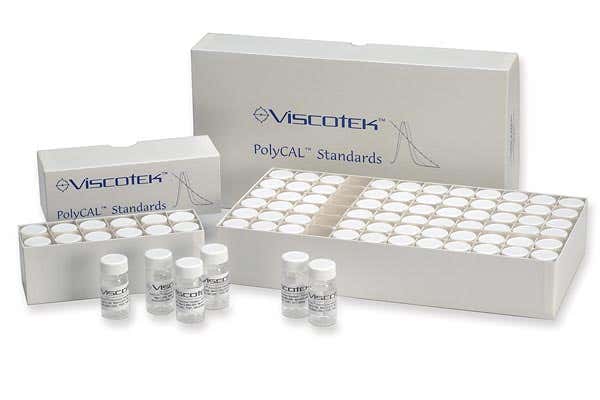Overview
Malvern Panalytical offers a wide selection of molecular weight standards for GPC/SEC. These are available as pre-weighed standards for ease of preparation. Simply add the correct volume of the required solvent to prepare these molecular weight and intrinsic viscosity standards at a known and accurate concentration.
Standards for conventional and universal column calibration have a broad molecular weight range and are available for organic and aqueous applications.
Standards for light scattering and triple detection are characterized using instruments verified with NIST-traceable materials and are available for organic and aqueous applications. They can be used to simultaneously calibrate and normalize detectors and to determine inter-detector volumes and peak broadening parameters.
- Pre-weighed molecular weight standards reduce preparation time and effort and increase reproducibility
- Column calibration standards cover a wide molecular weight range
- NIST-traceable light scattering/triple detection standards
- Calibrate and normalize detectors and calculate detector offsets and band broadening corrections in a single step to reduce calibration time
- Polystyrene and PMMA standards for organic applications
- Polyethylene oxide, pullulan and dextran standards for aqueous applications
How it works
Malvern Panalytical's molecular weight standards are pre-weighed into a glass vial. Simply add the desired amount of solvent to achieve the right concentration.
Column calibration standards are run in series through a GPC/SEC system. The elution times of the various molecular weight standards are then used as a reference for the unknown material. Relative molecular weights are obtained when the standard and sample polymers are different.
Light scattering/triple detection standards are used to characterize the detector responses which are then used in the measurement of absolute molecular weight. Normalization factors, detector offsets and band broadening corrections are calculated simultaneously to reduce calibration time.
Specification
Polystyrene (PS)
| Standard material | Polystyrene (PS) |
|---|---|
| Applications | Synthetic polymers |
| Calibration type | Column calibration & triple detection calibration (narrow) and verification (broad) |
| Standard type | Bulk powder, pre-weighed individually and mixed (for HT-GPC) |
| Molecular weight range | 1000 Da – 4.5 MDa |
Poly-methyl-methacrylate (PMMA)
| Standard material | Poly-methyl-methacrylate (PMMA) |
|---|---|
| Applications | Synthetic polymers |
| Calibration type | Column calibration & triple detection calibration (narrow) and verification (broad) |
| Standard type | Bulk powder or pre-weighed |
| Molecular weight range | 3 kDa – 1 MDa |
Polyethylene oxide (PEO)
| Standard material | Polyethylene oxide (PEO) |
|---|---|
| Applications | Water soluble polymers |
| Calibration type | Column calibration & triple detection calibration (narrow) |
| Standard type | Pre-weighed |
| Molecular weight range | 50 kDa to 250 kDa |
Pullulan
| Standard material | Pullulan |
|---|---|
| Applications | Water soluble polymers |
| Calibration type | Triple detection calibration (narrow) |
| Standard type | Bulk powder or pre-weighed |
| Molecular weight range | 5 kDa to 700 kDa |
Dextran
| Standard material | Dextran |
|---|---|
| Applications | Water soluble polymers |
| Calibration type | Triple detection verification (broad) |
| Standard type | Pre-weighed |
| Molecular weight range | 50 kDa – 100 kDa |

